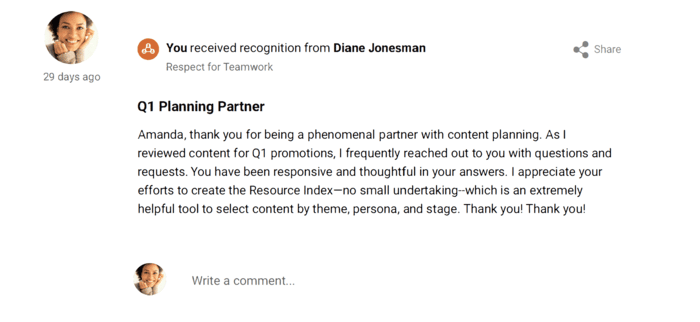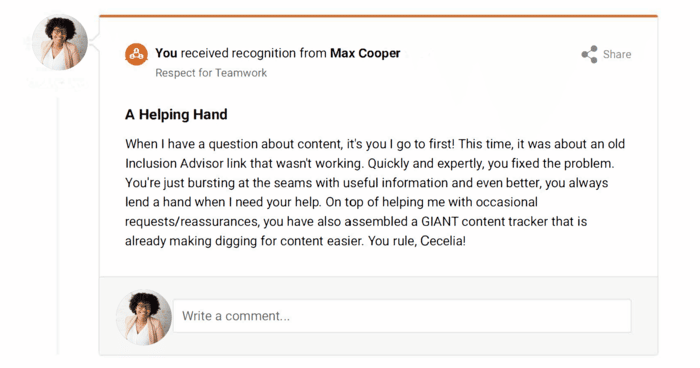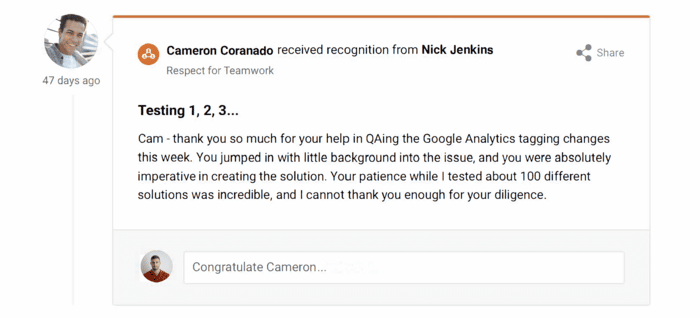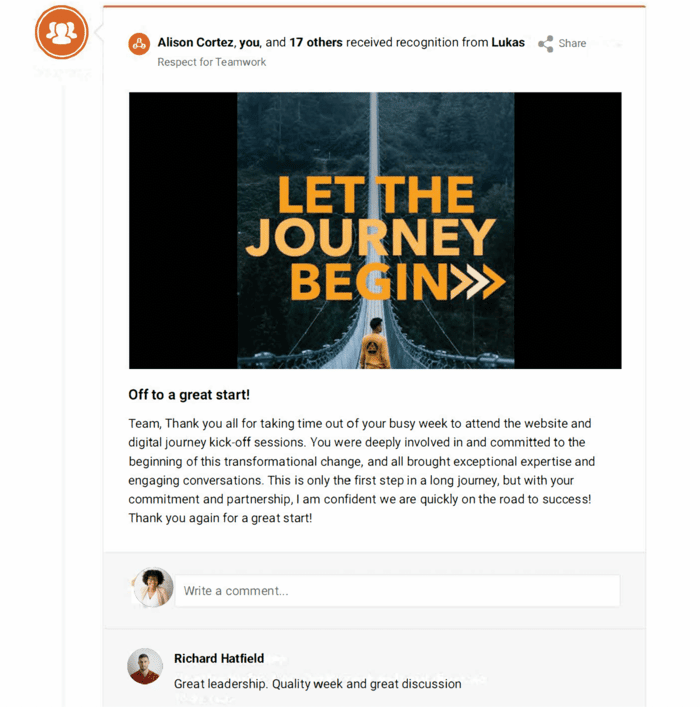11 Employee Recognition Letter Examples & How to Write Your Own

When was the last time your workplace acknowledged all your contributions? Especially given all the challenges you’ve faced in the past three years?
If you have to think about it for too long, you might feel unappreciated or wonder whether you're contributing to your team. The same is true for those who report to you, right? That’s where a recognition letter comes in. After all, you certainly don't want your long-term employees and other new team members to feel this way, so you might consider writing them an employee recognition letter.
Writing an employee recognition letter can make a huge difference, with benefits ranging from improved morale to better retention. Best of all, you don’t need to write a formal recognition letter — a quick note or semi-formal letters can have a profound impact.
Nevertheless, regardless of how grateful you are for your employees and all their efforts, it can be difficult to put it into words. Fortunately, here is a complete guide that includes sample employee recognition letters. You’ll learn how to write an employee recognition letter and send impactful messages of gratitude to your team.
Why should you write an employee recognition letter?
Organizations often implement a continuous performance management approach to the way they develop their employees. The performance management process typically includes an ongoing series of meetings — or check-ins — between a manager and an employee.
These check-ins allow the manager to review objectives and provide feedback to ensure the employee's actions align with the organization's long-term goals. While ongoing feedback is a critical part of the performance management process, you can't forget to acknowledge the tangible results and all the work that an employee does well, day in and day out.
Many organizations ignore employee recognition because of the time and resources it takes to incorporate it into their processes. They might also feel it's not as beneficial as simple constructive feedback. However, the benefits of employee recognition make it well worth the effort.
And if your organization has a comprehensive recognition program in place – based on a platform such as Workhuman’s Social Recognition® solution – providing employee recognition becomes an integral part of a company’s culture of gratitude. It speaks volumes about what the company values, reinforcing company core values examples in action, and strengthens the brand associated with your company name.

Here are some reasons why you and your organization should start building a culture of recognition — including writing employee recognition letters:
Improved morale
A report from Workhuman and Gallup revealed that employees who receive recognition from a manager even just a few times per year are:
- 5x as likely to be actively disengaged
- 27% more likely to be struggling
- 74% more likely to not plan to be at their organization in one year
Thanks to the benefits of employee recognition, organizations can improve these metrics. Professionals who receive recognition tend to work more efficiently on group projects because they develop better relationships with their peers.
Overall, the improved moraleOpens in a new tab creates a positive feedback loop of employees feeling appreciated and – through peer recognition – expressing their appreciation for others at work.
Increased productivity
Another report from Gallup notes that recognition can lead to increased productivityOpens in a new tab in the workplace.
When a manager recognizes an employee's achievements, that employee can focus on their strengths and continue to exceed expectations.
Receiving acknowledgment also helps an employee to feel appreciated, encourages them to continue working toward their personal goals, and helps them advance the company's overarching objectives.
Better recruitment and retention
Another lasting impact that comes with providing employee recognition is better recruitment.
Consider a survey from Harvard Business ReviewOpens in a new tab, which revealed that 59% of participants say they've never had a manager who "truly appreciates" them.
This number indicates that many organizations don't take the time to recognize employees for their hard work. Therefore, by implementing a measure as simple as writing recognition letters, you can help your company stand out from competitors.
Qualified professionals looking for a positive work environment might be more likely to apply, making it easy for your organization to attract and retain the talent it needs to succeed.
Cost-effective solution
In addition to the impressive employee recognition statistics, recognition letters are also one of the most cost-effective solutions an organization can use.
Simply use your organization's existing email service – or use the office's pens, paper, and envelopes.
And if you invest in a comprehensive employee recognition technology solution – such as Workhuman’s Social Recognition® – you'll find that it's an affordable way to express your gratitude and foster positivity throughout your organization.
The major resource you'll use when providing recognition is your time, as you have to recognize what an employee did well and express your appreciation on paper or in an online feed.
How to write a letter of recognition in 9 steps

Here are nine key tips for writing an employee recognition letter:
1. Choose the appropriate format
Managers and HR departments can recognize the great work of employees using various mediums.
If you want to share your appreciation in a more personal and private way, consider an email or handwritten note. These mediums are perfect for expressing appreciation for a contribution to a project that you don't want others to know about yet.
But it’s important to note … while personal and private recognition has its place, you and your organization will get far greater impact and benefits with a comprehensive, strategic employee recognition program.
Not only does it make gratitude public, it also helps reinforce and advance your company values, build employee engagement, and reduce turnover.
Workhuman's Social Recognition® tool is an example of a comprehensive platform that allows anyone within the organization, including managers, to thank employees publicly.
2. Personalize the message
Some organizations use templates to create recognition letters, but this approach can feel disingenuous.
Employees will usually be able to detect copycat sentences and template-based letters of formal letters, and the insincerity will be especially obvious if the worker happens to share letters with another team member. Better to write letters in your own voice.
Be sincere with your appreciation by personalizing each message, being sure to include the employee name. It need not be a formal letter. In fact, a formal tone can be a turn-off. Tips include addressing the person by name, referencing the company name, writing each letter from scratch, discussing topics specific to the employee, and adding your own, hand-written signature.
Such a meaningful message will accurately reflect the hard work the employee put in to receive recognition in the first place.
3. Determine why you're writing the letter
While employees could receive recognition letters for various reasons, it’s important that you pinpoint why you've decided to write this one to this particular person.
Perhaps an employee has gone above and beyond their job description to promote the company's values. Perhaps they’ve completed a task that's important but usually goes underappreciated.
Other reasons you might be writing the letter include:
- You've noticed significant improvements in their performance.
- You'd like to encourage them to continue their impressive work.
- You want to give the employee credit for their contributions to company achievements.
- You want to make their achievements public to encourage other employees to follow suit.
- You want to share their achievements with customers to highlight your organization's positive culture.
(We’ll explore each of these recognition moments in further detail below, with a sample employee recognition letter for each example.)
Another way you might recognize employees is in their personal lives. This humanization allows employees to feel more connection and loyalty to their organizations and peers – and helps them feel appreciated beyond what they do at work. It might be a new home, a new baby, a work anniversary, or another important milestone.
One way to build a vibrant sense of community and connection is through Life Events® and Community Celebrations® – part of the Workhuman® Platform.
4. Recognize specific achievements
Whatever the reason for your letter, consider identifying and focusing on one or two key points.
However, you can recognize multiple achievements that specifically highlight these points. For instance, imagine you want to recognize an employee for their improved productivity.
You might begin your letter by saying how this goal is important because it aligns with your company's mission of exceeding client expectations. Then, you can elaborate on how the employee meets their weekly quota while maintaining high-quality work. You might even mention their efforts to help new employees learn the ropes.
6. Use active voice and positive vocabulary
When writing a recognition letter, try to use positive words to focus on what the employee did well – rather than what they didn't.
- For instance, you should say, "you demonstrated integrity" rather than, "you didn't showcase dishonest business practices."
It's also ideal to use active focus to emphasize the employee's achievements.
- For instance, if you said, "Sam was expertly trained under your supervision," it might sound like you're not giving the employee proper credit.
- Rather, you might say "You expertly trained Sam, so he could effectively contribute to his team."
7. Express your sincere appreciation
As simple as it sounds, it can be easy to forget to express your appreciation as you describe the employee's achievements.
Be sure to include an explicit "thank you" in your employee recognition letters. In this way, employees will have no doubt that you appreciate their hard work.
You can also elaborate on why you're thankful.
- For instance, you might appreciate that the employee's ability to meet strict deadlines improves the efficiency of all teams.
8. Share others' recognition
Though your recognition letter should focus on your appreciation for the employee, you can share input from others.
- For instance, other supervisors might've had good things to say about the employee's work ethic.
You might even include positive customer comments regarding the employee's performance. This additional input helps reinforce your points and assures the employee that you're not the only one who appreciates them.
9. Choose the right time to deliver
While knowing how to write a letter of recognition is important, determining when to send it is just as essential.
Try to avoid waiting too long after the employee's achievement, as they should know you appreciate their effort as soon as possible.
Additionally, if you wait too long, it might appear that you only provide recognition after the employee's work produces dramatic results.

11 sample employee recognition letters
When it comes to employee recognition, a commonly asked question is: “What types of things should I recognize?”
It can be a tricky question. After all, there’s a broad spectrum of activities that deserve to be recognized. It could be celebrating something an employee did with little effort – yet had a phenomenal impact on the company name.
It could be something that failed despite a herculean effort – yet produced a valuable learning moment. Or it could be an otherwise ordinary contribution – yet the employee made it uniquely special.
In other words, the real value of an employee’s effort is measured not just in what they accomplished, but in how they accomplished it.
With that in mind, here are some instances when employee recognition deserves your careful consideration. To bring each scenario to life, we’ve also included excerpts from actual, real-life employee recognition letter examples that managers and peers have written, celebrating the excellent job the humans in the organization have done.
1. Recognize employees for things you’d like to see them do more often
Did the employee do something great? Something you want them to keep doing?
Then recognize it. Employee recognition is one of the purest and most powerful forms of positive feedback – and a great way to reinforce and encourage the actions you’d like to see happen again and again.
Example:
You are a consummate idea generator and a key reason why we’re delivering exceptional content to the market. Thank you for continuing to bring a pragmatic product sense to the team and generating thought-provoking content that leads to new business. I look forward to seeing more innovation from you in the future. Keep pushing!
2. Recognize employees for something you’d like to see others doing
Did you see an employee do something you want others to emulate?
This is another great opportunity to recognize an employee – particularly when you have an online feed of recognition moments, like one provided in a values-based, social recognition platform such as Workhuman’s.
It’s a powerful way to send a message to other employees about what your department and company value most.
Example:
Your thoroughness sets a new standard for preparation and is something every employee should replicate. Your patience and teamwork are unmatched, and is a playbook for everyone at our organization. Thank you for your continued dedication and leading by example!
3. Recognize something that embodies company values
Recognizing behavior that is a clear embodiment of your organization’s values shows the employee – and your whole team – what it means to practice company values.
When you see behavior that closely aligns with those values, be sure to call it out with recognition messages.
Example:
This is a great example of patiently looking at a problem, troubleshooting, and finding the answer. I also appreciate the extra step you took by asking the vendor to add this to their documentation. You’ve embodied our company values of ‘Imagination’ and ‘Innovation’ at its finest. Thank you!
4. Recognize something that has helped your company achieve its mission and goals
Like values, a company’s mission, vision, and goals can sometimes feel very disconnected from day-to-day work. When you see activity that moves the needle on your core principles, recognize it. This is an outstanding way to make core values real in your employees’ everyday lives and help the company grow.
Example:
Undertaking a design system rebuild is a hugely challenging prospect by normal standards – let alone one for a full-scale global enterprise platform. It’s a testament to how effective this team can work together, collaborate, coordinate efforts – while being passionate about having the opportunity to make a real impact on our mission, our goals – and our bottom line.
5. Is it something above and beyond the call of duty?
One of the definitions of employee engagement is the application of discretionary effort – which is a fancy way of saying ‘she did something she really didn’t have to do.’
Sometimes this involves taking on tasks that are not our responsibility or are – at the very least – a stretch. Sometimes it involves working late or buckling down on productivity in order to complete an assignment.
When employees do tasks they don’t have to do – or take on responsibility they don’t have to take on – they almost always deserve recognition for their positive attitude.
Example:

6. Is it something others are noticing and talking about?
If you’ve got customers, vendors, managers, senior executives, or other employees buzzing in your ear about something great one of your team members is doing, chances are you have an opportunity for recognition. (If they haven’t beaten you to it through peer recognition.)
Example:
I wanted to thank you for the wonderful article you recently wrote! I shared it with the entire team! It’s a great resource for our team as a refresh of the messaging – or to share with customers. Not only has your content made all the difference, but it has helped our teammates in other departments with their communication with customers, as well. When people from other areas of the organization recognize your work, it shows the depth and breadth of your contributions. Fantastic job!

7. Is it something that is otherwise thankless?
Think about recognizing all the effort and attitude that goes into completing thankless tasks – even if they’re routine. After all, thankless tasks are some of the most challenging to complete, day after day.
So it’s incredibly motivating when, every once in a while, an employee realizes they’ve made a positive impression and someone is noticing and grateful for their daily grind. An occasional acknowledgment of such contributions can go very far in building employee engagement and motivation.
Example:
When I ran into laptop connectivity issues after hooking up a new monitor, I reached out to you and you responded within 10 minutes. What made your response special is that it was Saturday morning of Labor Day weekend. You patiently talked me through some troubleshooting steps and I was able to get up and running. While we were talking during the reboot, I asked if you were working. You told me it was your day off.

8. Is it something they’ve recently been recognized for?
Here’s your chance to be truly creative. If there is a new aspect of the work that you think deserves credit and acclaim, then by all means recognize it.
But if it is something the employee has been specifically thanked for within the last month or so, why not revisit that recognition post and add your congratulations?
Example:
Just wanted to add my thanks for the invaluable contributions and support you’ve provided over the past few months. We can always rely on you for your calm, reassuring demeanor, your vast experience, and the creative thinking you bring to each progress. We are moving forward with another soon-to-be customer with some exciting future projects, and that is – once again – in no small part due to your fantastic contributions. Thanks as always!
9. Is it something that has impacted company or team business results?
Results usually deserve praise and appreciation. It’s rare when we can draw a direct line from employee actions to business results. When you can do that, be sure you include recognition in the mix.
Example:
Thank you for delivering high quality, compelling, on-brand, and ‘of the moment’ digital event on such short notice. In less than six weeks you expertly pivoted from the cancellation of our physical conference and leaped into bold new thinking that resulted in our Livestream event. You were fearless in pursuit of our audacious goal of 10,000 registrants and charged furiously at it – obliterating the goal and achieving more than 15,000 attendees. This level of business success took thoughtful planning, decisive and quick action, creativity, and relentless outreach to secure exceptional guest speakers, high-profile customer stories, and new sponsorships.

10. Is it something that is an everyday part of their job?
If an employee executes an everyday task in a particularly successful or impactful way – one that catches your attention – you should recognize that action. If you believe an employee deserves recognition – but can’t quite put your finger on why – give it more thought.
Is she bringing something unique to the organization? Is he innovating in some way that impresses you?
Thanking someone for mundane tasks sets the bar low on recognition and cheapens its impact on everyone – so be sure when you do recognize, it is for a clear reason.
Example:
Your commitment to building and executing on a robust customer marketing plan is admirable. You clearly define your goals, strategy, and tactics, and take the time to communicate these to the team. You take a collaborative approach to working with your colleagues, and are always prepared, present, and on time to meetings.
11. Did they do something that made your life much easier?
Yes, this may seem personal, but so is recognition! Sometimes employees are thoughtful and give you small favors of time, attention, or energy that make an enormous impact.
If it was a small thing, it is worth a small award. If someone reached out to give you a big hand with a project, then give them a big thanks.
Example:
Thanks to you, I was able to unplug for a week and enjoy time with my family. I have full confidence in you and it was great to know we weren’t going to miss a beat. Thanks for your commitment to me and to the organization.
FAQs
When it comes to writing a recognition letter, here are some commonly asked questions:
How do you address a recognition letter?
In most cases, it's appropriate to address an employee by their first name to maintain a more authentic connection.
You can also use a greeting like "Dear" and include any other important information in the header, such as the company logo or the recipient's address.
How do you write a recognition letter to a company?
While many managers and HR departments write letters of recognition to employees, you can also express your gratitude to other companies. This practice ensures suppliers know you're grateful and helps maintain a positive relationship.
Recognition letters to companies are similar in that they should be personalized and specifically express why you're thankful for their work.
How do you write an award recognition letter?
If an employee receives an award for their hard work, consider writing a letter of recognition as a personalized accompaniment.
The letter should describe the award they got, whether it was a certificate or a monetary gift. You can also explain why they earned the award and include details about an award ceremony if there is one.
Bring a culture of recognition to your organization
Workhuman’s Social Recognition solution – part of the Workhuman Platform – makes it easy for anyone in your organization to recognize the great work of others. Discover firsthand how you can make employee recognition the lifeblood of your company – and realize the profound, bottom-line benefits a culture of gratitude can deliver.